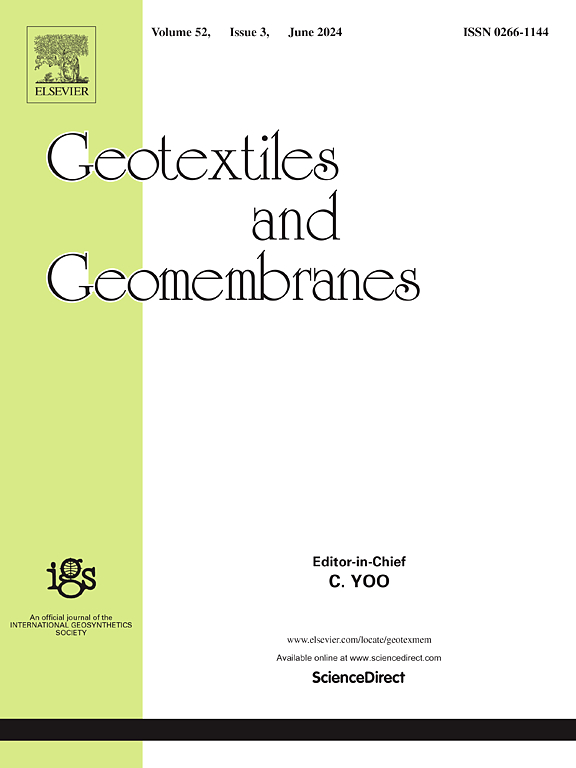吸芯非织造土工布除水性能评价
IF 6.2
1区 工程技术
Q1 ENGINEERING, GEOLOGICAL
引用次数: 0
摘要
道路基层和路基积水是造成道路病害的主要原因之一。为了抵消这种不利影响,本研究引入了一种新型土工合成复合材料,该复合材料由双轴聚丙烯土工格栅热粘合到吸芯非织造土工织物(WNWGs)组成。这种新型复合材料将排汗能力与强化相结合。与依靠深槽纤维进行润湿和排芯的吸湿编织土工布(wwg)不同,WNWGs的吸湿机制主要基于非织造土工布组分的微观结构和独特的纤维取向,并通过专有的化学处理将纤维从疏水性转化为亲水性进一步增强。这种修改允许WNWGs在保持传统非织造土工布的大侧向排水功能的同时,表现出快速润湿和排芯性能。为了评估该材料的排汗性能,在控制温度和相对湿度的条件下,在水和饱和土壤中进行了一系列的排汗试验。此外,还进行了接触角测量和扫描电子显微镜(SEM)显微分析,以阐明潜在的排芯机制。结果证实,与传统的非织造土工布相比,WNWGs具有优越的自发和强制润湿和排芯能力。研究结果为评价wnwg -土工格栅复合材料的性能提供了有价值的参考。本文章由计算机程序翻译,如有差异,请以英文原文为准。
Evaluation of water removal capability of wicking nonwoven geotextiles
Water accumulation in road bases and subgrade is one of the primary causes of road distress. To counteract this adverse impact, this study introduces a novel geosynthetic composite, consisting of biaxial polypropylene geogrids heat-bonded to wicking nonwoven geotextiles (WNWGs). This new composite integrates wicking capabilities with reinforcement. Unlike wicking woven geotextiles (WWGs), which rely on deep-grooved fibers for wetting and wicking, the wicking mechanism of WNWGs is primarily based on the microstructure and unique fiber orientation of the nonwoven geotextile component, further enhanced by proprietary chemical treatment to convert the fibers from hydrophobic to hydrophilic. This modification allows WNWGs to exhibit rapid wetting and wicking properties while preserving the large lateral drainage functionality of conventional nonwoven geotextiles. To assess the wicking performance of this material, a series of wicking tests were conducted in both water and saturated soils under controlled temperature and relative humidity. Additionally, contact angle measurements and microscopic analyses using Scanning Electron Microscopy (SEM) were conducted to elucidate the underlying wicking mechanisms. The results confirmed that the WNWGs possessed superior spontaneous and forced wetting and wicking capabilities compared to traditional nonwoven geotextiles. The findings offer valuable reference for evaluating the performance of the WNWG-geogrid composite.
求助全文
通过发布文献求助,成功后即可免费获取论文全文。
去求助
来源期刊

Geotextiles and Geomembranes
地学-地球科学综合
CiteScore
9.50
自引率
21.20%
发文量
111
审稿时长
59 days
期刊介绍:
The range of products and their applications has expanded rapidly over the last decade with geotextiles and geomembranes being specified world wide. This rapid growth is paralleled by a virtual explosion of technology. Current reference books and even manufacturers' sponsored publications tend to date very quickly and the need for a vehicle to bring together and discuss the growing body of technology now available has become evident.
Geotextiles and Geomembranes fills this need and provides a forum for the dissemination of information amongst research workers, designers, users and manufacturers. By providing a growing fund of information the journal increases general awareness, prompts further research and assists in the establishment of international codes and regulations.
 求助内容:
求助内容: 应助结果提醒方式:
应助结果提醒方式:


